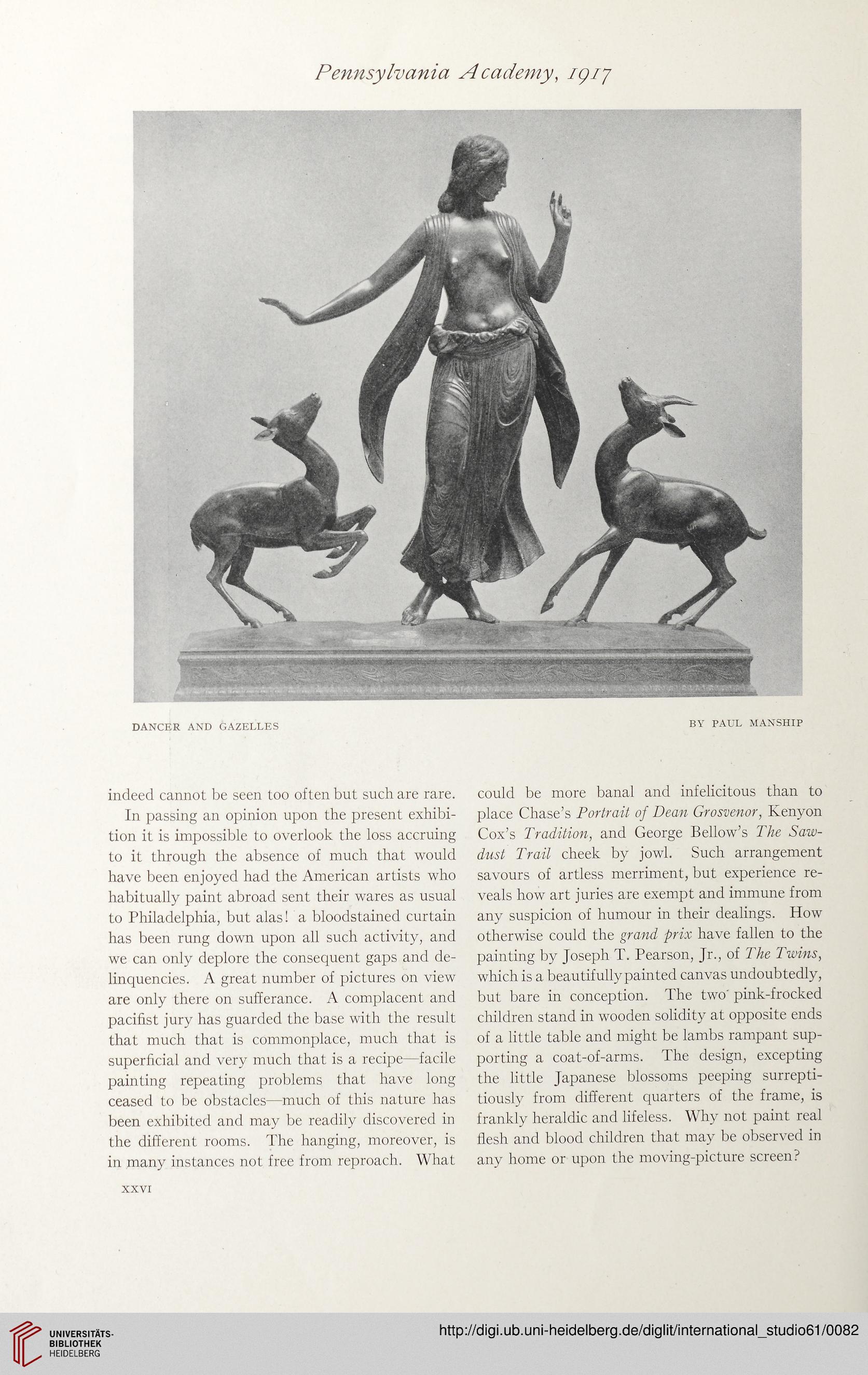Pennsylvania Academy, 1917
DANCER AND GAZELLES
BY PAUL MANSHIP
indeed cannot be seen too often but such are rare.
In passing an opinion upon the present exhibi-
tion it is impossible to overlook the loss accruing
to it through the absence of much that would
have been enjoyed had the American artists who
habitually paint abroad sent their wares as usual
to Philadelphia, but alas! a bloodstained curtain
has been rung down upon all such activity, and
we can only deplore the consequent gaps and de-
linquencies. A great number of pictures on view
are only there on sufferance. A complacent and
pacifist jury has guarded the base with the result
that much that is commonplace, much that is
superficial and very much that is a recipe—facile
painting repeating problems that have long
ceased to be obstacles—much of this nature has
been exhibited and may be readily discovered in
the different rooms. The hanging, moreover, is
in many instances not free from reproach. What
could be more banal and infelicitous than to
place Chase’s Portrait of Dean Grosvenor, Kenyon
Cox’s Tradition, and George Bellow’s The Saw-
dust Trail cheek by jowl. Such arrangement
savours of artless merriment, but experience re-
veals how art juries are exempt and immune from
any suspicion of humour in their dealings. How
otherwise could the grand prix have fallen to the
painting by Joseph T. Pearson, Jr., of The Twins,
which is a beautifully painted canvas undoubtedly,
but bare in conception. Idle two' pink-frocked
children stand in wooden solidity at opposite ends
of a little table and might be lambs rampant sup-
porting a coat-of-arms. The design, excepting
the little Japanese blossoms peeping surrepti-
tiously from different quarters of the frame, is
frankly heraldic and lifeless. Why not paint real
flesh and blood children that may be observed in
any home or upon the moving-picture screen?
XXVI
DANCER AND GAZELLES
BY PAUL MANSHIP
indeed cannot be seen too often but such are rare.
In passing an opinion upon the present exhibi-
tion it is impossible to overlook the loss accruing
to it through the absence of much that would
have been enjoyed had the American artists who
habitually paint abroad sent their wares as usual
to Philadelphia, but alas! a bloodstained curtain
has been rung down upon all such activity, and
we can only deplore the consequent gaps and de-
linquencies. A great number of pictures on view
are only there on sufferance. A complacent and
pacifist jury has guarded the base with the result
that much that is commonplace, much that is
superficial and very much that is a recipe—facile
painting repeating problems that have long
ceased to be obstacles—much of this nature has
been exhibited and may be readily discovered in
the different rooms. The hanging, moreover, is
in many instances not free from reproach. What
could be more banal and infelicitous than to
place Chase’s Portrait of Dean Grosvenor, Kenyon
Cox’s Tradition, and George Bellow’s The Saw-
dust Trail cheek by jowl. Such arrangement
savours of artless merriment, but experience re-
veals how art juries are exempt and immune from
any suspicion of humour in their dealings. How
otherwise could the grand prix have fallen to the
painting by Joseph T. Pearson, Jr., of The Twins,
which is a beautifully painted canvas undoubtedly,
but bare in conception. Idle two' pink-frocked
children stand in wooden solidity at opposite ends
of a little table and might be lambs rampant sup-
porting a coat-of-arms. The design, excepting
the little Japanese blossoms peeping surrepti-
tiously from different quarters of the frame, is
frankly heraldic and lifeless. Why not paint real
flesh and blood children that may be observed in
any home or upon the moving-picture screen?
XXVI




